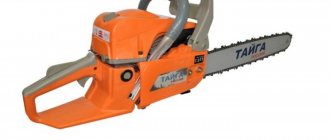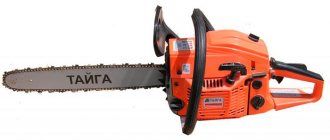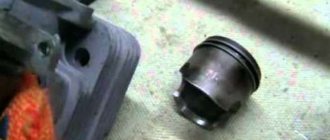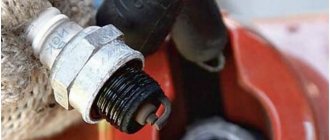Specifications
First of all, it is worth considering the characteristics of the engine and fuel system. No one will be surprised that the Taiga 214 runs on a two-stroke engine whose volume is 75 cm3. The cylinder is characterized by a unique location - perpendicular to the guide bar. The crankshaft speed is modest, 7,000 rpm. This is quite enough to cope well with various tasks.
The tool is small but very powerful. If you run the tool at maximum rotation, you can squeeze 3.5 horsepower out of the Taiga 214, which makes it possible to use a tire up to 38 cm in length.
It is important to take care of your engine and tool by choosing the best fuel for it. Like all two-stroke chainsaw engines, the 214 Taiga engine requires an ideal mixture, which consists of high-quality gasoline and synthetic oil. In this case, it is important to take into account the value of 600 g/kW, h, which is responsible for the consumption of the oil-fuel mixture. It is worth studying the instructions first to ensure that you mix the mixture accurately and adhere to the recommended ratio. In terms of the structure of the fuel system, manufacturers are not surprised. This comes standard with a filter, carburetor and high-quality fuel line.
When considering the features of the Taiga 214 chainsaw, one should not lose sight of the carburetor, which is equipped with a fuel pump whose diaphragm operates due to air pulses. Adjusting the carburetor is easy because it has several screws that help you make fine adjustments. A pair of screws are responsible for minimum and high speed, and the third is for idle speed.
In Taiga 214 you can see an interesting addition in the form of an air damper. It is equipped with a control lever that allows the operator to quickly adjust the cold air flow.
A description of the features of the Taiga 214 would not be complete without characteristics of the guide bar and chain. The tire has a shock-absorbing insert, which is distinguished by a driven sprocket. Thanks to metal springs and groove-shaped connections, it is attached to the main rail. Thanks to the structure, working with the tool becomes simple. The chain pitch does not exceed 9.3 mm.
The manufacturers decided to install the tire on the opposite side to the starter. It is located next to the brake system cover, which has fasteners consisting of a pair of nuts. Here you can also find a screw that is responsible for adjusting the chain tension.
The ignition system also has features. Thanks to the non-contact magnetic system, the ideal operation of the system even at maximum speed, the chainsaw starts smoothly and quickly. Sparking is ideal thanks to the diode bridge and generator coil.
The plunger pump supplies oil through the line. The pump is attached to the main sprocket. Overall, the oil supply is automatic and efficient. This reduces chain wear and allows you to work efficiently with the tool. The best lubricating oils are those that have excellent adhesive characteristics.
For lovers of domestic chainsaws of decent quality and good characteristics, we offer our article - Review of the Lesnik 3816 chainsaw.
The starting mechanism in this chainsaw model is located next to the flywheels; the starter is manual.
Possible problems of Taiga 214
Repairs to the Taiga 214 can be carried out by the chainsaw operator independently. But the main thing is to figure out the cause of the problem. A common occurrence is that the saw does not start. After pulling the chainsaw starter cord, nothing happens. The engine seems to start running, but the next moment it stops. The operator continues to pull the cord, but the chainsaw does not start. Is this a familiar problem? There are many reasons why the Taiga 214 does not start:
- The throttle is installed in the wrong position.
- The carburetor is flooded.
- The spark plug or air filter needs to be cleaned or replaced.
- The screen inside the muffler becomes clogged with carbon deposits.
First of all, you need to look at the throttle, change its position and try to start the saw. If there is any hint that the engine is starting to run, you need to adjust the throttle.
If the chainsaw still won’t start, the culprit may be a flooded carburetor. If everything is fine with the carburetor, then you need to clean the spark plugs and air filter. If one or both of the two components is damaged, it must be replaced.
If your chainsaw won't start after cleaning the filter and spark plug, or replacing one or the other, then it's time to check the spark-proof screen in the muffler. The screen can become clogged with carbon deposits, especially when the saw has dirty air filters. A clogged filter causes the saw to work harder. This results in a large amount of unburned fuel remaining and deposits. In addition, carbon accumulates on the screen. Regular inspection of the Taiga 214, timely cleaning and adjustment of components will avoid a lot of problems.
Video
Carburetor
The carburetor of the Taiga 245 chainsaw deserves special attention, because... the bulk of the flaws fall directly on this address. Taiga 245 is equipped with a floatless membrane-type carburetor KMP-100US, with a built-in pump. The pump supplies fuel from the tank to the carburetor.
The main structural elements of the carburetor:
- pressure regulator;
- air damper;
- throttle valve;
- mixture adjustment screws;
- fuel pump.
Some Taiga 245 chainsaws were equipped with Japanese Walbro carburetors. There is no data on them.
It is not worth adjusting the carburetor without events, because... It comes from the factory with good adjustments. Additional adjustment of the carburetor may be necessary if there is a sudden change in temperature, or after disassembling the carburetor itself. It should be done strictly according to the instructions using 3 screws responsible for adjusting the supply of the fuel-air mixture.
Taiga 245
The creation of this chainsaw has long been discontinued, no matter how annoying it may sound, until now you can buy it in the field of used equipment. According to the manufacturer, this tool belongs to the semi-professional class of tools. Indeed, in Russian times it was widely used in forestry, including for felling trees.
READ Ignition Adjustment Stihl 180
The chainsaw is driven by a two-stroke single-cylinder engine with a power of 3.5 hp, equipped with a 400 mm bar and a 76-link saw chain. The unit is made of metal, there are practically no plastic parts. Among the main disadvantages of the Taiga 245 chainsaw, we highlight the presence of vibration and very high weight - over 9 kilograms, in running order, and also high consumption of fuel and lubricants.
Technical characteristics and description of the chainsaw design
Engine and fuel system
The Taiga 214 chainsaw is equipped with a two-stroke internal combustion engine with a volume of 75 cm 3, the cylinder of which is located perpendicular to the chainsaw tire. The maximum crankshaft rotation speed is 7 thousand rpm, which is a rather modest figure compared to imported analogues. The power of the tool at maximum speed is 2.6 kW or 3.5 liters. With. this allows the use of a tire with a working length of 38 cm.
To operate, Taiga 214 uses a mixture of gasoline and oil for two-stroke engines. Fuel consumption is 600 g/kW, h. The proportion of the fuel mixture is twenty parts gasoline to one part oil.
The fuel system consists of a carburetor, fuel line and filter. The fuel filter is installed in the tank. The carburetor in the Taiga chainsaw is a single-chamber, diaphragm carburetor with a built-in fuel pump.
The fuel pump diaphragm is driven by an air pulse from the crankcase. The carburetor has three adjusting screws, one of which is responsible for adjusting the idle speed, the other two for working at low and maximum speeds.
The carburetor also has an air damper with a control lever connected to it, with the help of which the operator can regulate the air supply when starting a cold engine.
Performance overview
The Taiga line of chain units includes the following units:
- for home use (low power operation, up to 1.7 kW);
- semi-professional (work at medium power, up to 3 kW, with intensive regular operating loads);
- professional (work at high power, up to 6.5 kW);
- Gasoline sawmills Taiga with autonomous engines and maximum efficiency of lumber output (operation at power up to 20 kW).
The technical characteristics of the Taiga chainsaw meet safety requirements; the design has a large strength margin and resistance to any load.
Taiga-214
The Taiga-214 chainsaw is characterized by:
- long battery life;
- low fuel consumption;
- ability to saw trees with a diameter of up to 30 cm;
- stability of traction performance;
- automatic oil supply by a plunger type pump.
Chain unit parameters:
- 2-stroke engine power - 2.5 kW;
- cylinder volume - 65 cm³;
- tire length - 38 cm;
- oil tank - 0.25-0.3 l;
- fuel tank - 0.8 l;
- weight - 8.8 kg;
- dimensions - 857x280x272 mm.
Currently reading: How to set the ignition on a chainsaw
In comparison with the Taiga-245 chainsaw, the technical characteristics of which include more powerful parameters, the 214 model is unpretentious to fuels and lubricants.
Taiga-245
The chain model Taiga-245 of the semi-professional class, due to its low fault tolerance, has not found wide distribution on a production scale, but due to its high productivity and the ability to perform sawing of any complexity, it is used in everyday life. It has the following features:
- heavy weight, about 9 kg;
- starting system with a manual starter, stopping with a toggle switch;
- simplified adjustment of a floatless carburetor with a built-in pressure regulator and booster diaphragm pump;
- ignition advance from magneto EM-2 AM-17V;
- ability to fell trees with a volume of 0.35 m³.
Technical characteristics of the Soviet saw Taiga-245:
- chainsaw power - 2.6 kW;
- engine type - 1-cylinder 2-stroke;
- fuel tank capacity - 0.7-0.8 l;
- oil tank capacity - 0.25-0.35 l;
- productivity - 70 cm²/s;
- Fuel consumption at maximum power is 600 g/kW*h.
The saw set includes:
- universal chain with a pitch of 9.3 mm;
- saw bar 40 cm long.
Taiga-3850
Chainsaw BP-3850 is a 3.85 kW unit with the following equipment:
- quick start system at low ambient temperatures;
- booster pump;
- saw bar 45 cm long;
- automatic chain lubrication system;
- anti-vibration system;
- adjustable oil pump;
- overheating protection mechanism;
- chrome plating of the cylinder working surface.
The manufacturer equipped the tool with a 2-stroke engine with a displacement of 52 cm³ and a rotation speed of 9000 rpm. Saw weight: 5.3 kg.
Refill containers:
- fuel tank - 0.55 l;
- lubricant tank - 0.26 l.
Technical and operational parameters of the professional chainsaw Taiga-4000:
- power - 4 kW;
- idle speed (idle) - 2800 rpm;
- working volume - 58 cm³;
- tire length - 45 cm;
- chain pitch - 0.325";
- fuel tank capacity - 0.55 l;
- volume of the chain lubrication tank - 0.26 l;
- weight - 7.6 kg.
The main advantages of the model are:
- increased motor life;
- made of shockproof plastic;
- presence of a nylon filter;
- rich equipment - 2 tires of 72 links and 2 chains of 18".
Taiga-4500
The 4500 Series gasoline unit is equipped with a centrifugal air cleaning system and an inertia-type emergency stop mechanism, which reduces the likelihood of a kickback causing injury.
The model 4500 differs from the previous TBP-4000 saw only in its power increased by 500 W. The design, color and performance are similar.
Taiga-6300
The Pro class gasoline tool TBP-6300 has a high degree of assembly based on a 6.3 kW 2-stroke power plant, is equipped with a chrome-plated piston group and 2 compression rings, a carburetor with a primer and a kick starter with an easy start system.
The length of the guide bar is standard and is 45 cm. The basic package includes;
- 2 tires;
- 2 chains;
- a set of keys;
- measuring cup.
Structurally, the Taiga 245 saw is made with a minimum of plastic parts, which negatively affects its weight category; the dry weight of the tool with the saw set is less than 9 kg.
- The drive of the 16-inch saw set is realized from a 2-stroke low-speed power unit with a power of 2.5 kW. The cylinder volume of 75 cm3 ensures stable engine traction characteristics and a sufficient supply of torque in all operating modes.
- The operational feature of the tool is that it works on a gasoline-oil mixture prepared in a ratio of 20:1.
- The oil, which lubricates and cools the parts of the saw set, the bar and the saw chain, is supplied to the cut by a pump with constant output. Its increased consumption is compensated by the low cost of domestic lubricants.
Electronic ignition does not require separate maintenance. The main difficulty for novice sawyers is setting up the fuel supply system.
Taiga 214
The functionality of this model determines its suitability for the effective mechanization of work on dumping dead wood, sawing fuel wood and preparing construction wood for installation. The high performance of this model is achieved due to the traction parameters of a carburetor two-stroke engine with a volume of 65 cm3 and a power of 3.5 hp.
The layout of the tool takes advantage of the gearless drive of a 16-inch saw guide bar, a balancing mechanism that meets modern requirements for starting systems, fuel supply, cooling and lubrication of the saw set.
The advantages of the 214 series chainsaw:
- long battery life and economical fuel consumption;
- unpretentiousness to the used fuels and lubricants;
- ability to work with wood with a diameter of up to 300 mm;
- stability of traction characteristics in operating modes.
Taiga 245
The model, universal in many respects, is aimed at mastering large volumes of sawing work of varying complexity. The capabilities of the tool are effectively realized by the power of a 3-horsepower, low-speed power unit with a cylinder volume of 75 cm3.
The list of advantages of the 245 series chainsaw:
- lighter weight compared to the previous model (within 4.8 kg);
- manual cord starter with quick start device;
- simplified carburetor adjustment without a float type, with a built-in pressure regulator and booster pump;
- possibility of felling and bucking wood with a diameter of 3500 mm;
- time-saving disassembly of the saw set for sharpening or replacing the saw chain.
The engine runs on a gasoline-oil fuel mixture prepared in a ratio of 20:1, which enters the carburetor from an internal tank with a volume of 600 ml. To cool and lubricate the saw set, standard summer or winter engine oil can be used.
Taiga 3850
A household-grade chainsaw with a powerful drive and modern technical equipment is capable of mastering a wide range of chores related to sawing any wood, including dense and frozen wood with a diameter of up to 500 mm.
The model is equipped with a 4.3-horsepower engine with an easy start device and a booster pump, a 20-inch headset with an automatic chain lubrication system.
Work comfort is ensured by:
- full-fledged vibration damper;
- modern case design;
- excellent balance and convenient handle shape for working from different positions.
Despite the variety of chainsaw imports, the Taiga 3850 model is still in stable demand.
The most common breakdowns of the Taiga 214 and their elimination
As with any equipment, breakdowns sometimes occur in the Taiga chainsaw; we will list the most common ones and consider how to diagnose and fix the malfunction.
Engine won't start
The most likely reason that the engine does not start is the lack of a spark between the spark plug electrodes or an interruption in the fuel supply. In this regard, the following actions must be taken:
- Check the spark and condition of the electrodes on the spark plug and, if necessary, clean or replace it.
- Check the presence of fuel in the tank.
- Inspect the chainsaw for fuel leaks through torn fuel lines, and repair if found.
- Clean the fuel filter
- If the spark plug is wet and there is a spark on it, the most likely cause of the breakdown is a poor-quality fuel mixture. To fix this, you need to adjust the carburetor.
The engine does not develop full power
- It is necessary to check what position the saw chain brake is in; if it is on, turn it off.
- If the Taiga 214 confidently holds idle speed and at the same time does not develop full power, the reason is most likely in the carburetor settings. The high speed screw needs to be adjusted.
- Check the engine crankcase for leaks, if the idle speed fluctuates and eliminate them if detected
The instrument stalls
If the chainsaw stalls, the actions described in the paragraph “Engine will not start” will help.
Advantages and disadvantages
- The Taiga 245 chainsaw differs from modern imported chainsaws in its unpretentiousness to the quality of fuels and lubricants, routine maintenance, high level of maintainability, and lower operating costs.
- For motor and chain material, winter and summer engine oils of the Russian assortment are used.
- Like in a movie theater, plastic gadgets have a positive effect on the mechanical strength of the tool and the reliability of loaded components and assemblies.
- The Taiga saw has no significant restrictions on operational loads, therefore it is used to perform work with dense and frozen wood with a diameter of 300-350 mm.
The disadvantage is still considered to be its high weight, relative to similar models of other brands. The resource of the cylinder and connecting rod-piston group is insufficiently developed.
.
saw 245 in the works
Taiga Profi TBP-4000
One of the latest developments by the designers of the Degtyarev plant, the 4000 series chainsaw, equipped with a 4-kilowatt engine and a high-performance 450 mm headset, has the working properties of a professional-class tool.
The design of the saw weighing 4.9 kg provides:
- the presence of an increased engine service life by applying chromium-nickel wear-resistant coatings on the working surface of the cylinder and the rubbing parts of the connecting rod crank;
- easier access to the air intake device and fuel equipment of the tool, mounting of the guide bar, lids of the filling tanks;
- increased reliability of the drive and the oil pump itself of the automatic accounting lubrication system.
READ Adjusting the Husqvarna Trimmer
Safety of work is guaranteed by a comfortable grip of the saw, quick operation of the hand brake of the saw chain, and anti-slip rubber pads on the handles.
Chainsaw doesn't cut well
- In this situation, the problem is most likely a dull saw chain of the tool. It needs to be replaced with a new one or sharpened.
- Check the supply of lubricant to the saw bar; if it is missing, diagnose the lubrication system and eliminate malfunctions.
The tire pulls to the side
- It is necessary to inspect the tire and, if increased wear is detected, replace it with a new one.
- The teeth of the chain on one side are much higher than the teeth on the other side; it is necessary to sharpen the chain correctly and adjust the cutting depth.
The driven tire sprocket rotates with jamming
The problem is that debris has gotten into the sprocket bearing, you need to wash the tire in gasoline and check again; if such actions do not help, then the cause is wear of the bearings and the tire needs to be replaced.
The chain spins at idle
The main reasons why the chain may spin at idle are incorrect idle speed adjustment on the carburetor and a broken spring in the clutch mechanism of the tool. You must first inspect the clutch for faults and eliminate them if any, and then, if necessary, adjust the idle speed on the carburetor.
Adjusting the carburetor of the Taiga 214 chainsaw
Carburetor adjustment must be carried out during the break-in period, to reduce the maximum number of engine speeds, as well as in winter and in the event of malfunctions related to the quality of the fuel mixture and its quantity. A small slotted screwdriver is required for adjustment.
The initial adjustment of the Taiga 214 carburetor is carried out with the chainsaw turned off, and the final adjustment with the chainsaw running and warmed up.
The idle speed adjustment screw is designated by the letter “X”, the low speed screw is “P”, the remaining screw is responsible for the quantity and power at maximum speed.
For initial adjustment, it is necessary to set the low and high speed screws to the 1¼ position from the fully tightened state, then start the chainsaw, let it warm up and carry out the final adjustment of the screws until maximum speed and power are obtained.
Maintainability
Specifically, many potential buyers are attracted by the possibility of independent, affordable maintenance and major repairs. The independent solution of adjustment and repair problems is facilitated by a highly informative instruction manual and spare parts available in the range and price range.
Timely and fully completed home repairs can reduce operating costs by almost half and reduce the level of dependence on service and repair structures.
Related Posts
Chainsaw Taiga 245
Taiga 245 is a chainsaw from a Russian manufacturer, produced at the Degtyarev plant, abbreviated as ZID. The high power of the motor allows it to be used both for work in the forest and for domestic needs. Today, the Taiga chainsaw is obsolete, but continues to enjoy popularity among the country's population. The saw rarely breaks, so let’s look at the main possible breakdowns and how to remove them with your own hands.
IMPORTANT. An experienced electrician leaked to the network the secret of how to pay half for electricity, a legal way. Read more
Application
Despite its power, the Taiga 245 chainsaw was not widely used by woodcutters (of which there are plenty of reviews about the saw) due to its low fault tolerance. Still, when working in the forest, you need a more reliable tool: Stihl, Makita, Husqvarna. Carburetor adjustment. The Taiga 245 chainsaw is different from a modern chainsaw. The saw found its main use in everyday life. It is perfect for all household purposes:
- cut a slab;
- cut down a small tree;
- saw old boards;
- trim branches;
- buck the whips.
Device
Taiga 245 is a modern chainsaw, made in a plastic case made of impact-resistant material. A photo of this chainsaw can be seen below Taiga 245 chainsaw from the carburetor and. Is not afraid of falls or impacts of medium strength, because... Most of the parts are made of metal. It should be noted that it weighs 8.95 kg, not including fuel. Such saws weigh significantly less.
Saw dimensions: 900 x 280 x 300. Supplied complete with a saw set based on a 40 cm bar and a chain with a pitch of 9.3 mm.
The Taiga chainsaw is based on a 2-stroke internal combustion engine with a power of 2.6 kW, which is achieved when the crankshaft rotates at 7000 rpm. The working volume is 75 cubic cm. The piston group cylinder is not hardened, this reduces the service life of the chain saw. Taiga 245 is a chainsaw with additional carburetor adjustments. This aspect is important for huge volumes of work, where the saw operates under load for a long time, virtually without stopping. In domestic use, it is not critical whether the piston is hardened or not. The piston size is 50 mm in diameter. The manufacturer advises using the chainsaw for less than 40 minutes; after this time, the tool should rest.
The chainsaw is not hazardous to the environment provided it is used with specially designed oils.
Taiga 245 uses universal motor oil for both the chain and the motor. It is diluted in a ratio of 1 to 20. Yes, yes, specifically 1/20 - this is a distinctive feature of the Taiga 245 saw. The brand of gasoline is AI-92. As noted above, the same oil is used to lubricate the chain as is used in the engine. In summer, the oil should be diluted with gasoline in a ratio of 1/4. According to reviews from many saw owners, used oil (waste oil), for example from a car engine, can be used to lubricate the chain.
Carburetor
The carburetor of the Taiga 245 chainsaw deserves special attention, because... most of the defects occur specifically in it. The carburetor of the Taiga 245 chainsaw may require additional carburetor adjustment. Taiga 245 is equipped with a floatless membrane-type carburetor KMP-100US, with an integrated pump. The pump supplies fuel from the tank to the carburetor.
Chainsaw repair Taiga. Why does the Taiga chainsaw not start?
Disassembly and assembly of the Ural chainsaw. Magneto replacement.
Probably many people now have among their tools such a tool as a chainsaw. This is undoubtedly a very necessary tool in the household, but like every tool it tends to break. One of the most popular brands of chainsaw is Taiga 245
— Engine – single-cylinder, two-stroke, gasoline;— Power 2.6 kW;— Fuel consumption 600 g kW per hour;— Overall dimensions 280*900*300 mm;— Weight – 8.95 kg. A photo of this chainsaw can be seen below
The moment you decide that you need a chainsaw, you need to decide how often you will use it, as well as for what purposes. By visiting the store, you can find chainsaws of different classes; the lowest-powered of them are amateur models that can withstand occasional use. In this case, you should count on a power that does not exceed 2 kW.
If the load is more than 40 minutes a day, then you should pay attention to semi-professional models. With their help, it will be possible to carry out construction, working daily for up to 10 hours straight. The power in this case rises to 3 kW, the diameter of the tree trunk can be 40 cm. However, holding such a tool in your hands will be much more difficult, because its weight is 6 kg.
Professional-level chainsaws have a power that reaches 6 kW. This equipment is capable of long hours of daily use. It is better not to purchase such a device for personal needs, because it is quite expensive, and the instrument will weigh more than 6 kg. Such a load will be noticeable for an untrained master who has no experience working with such a tool.
Choosing a chainsaw class is not the most important task when purchasing such a tool. It is also important to decide on a manufacturer who has managed to establish itself in the market for such equipment. The Taiga chainsaw is not known to a very wide circle of buyers today, but its price is affordable, and the tool itself has excellent characteristics.
This tool belongs to the semi-professional class and has a relatively light weight, reaching 8.95 kg. The working tire of this equipment has a length of 40 cm. This, according to buyers, is quite enough to cut a 30-cm log. The Taiga chainsaw is powered by a two-stroke gasoline engine with a power of 2.6 kW.
The chain pitch is equivalent to 9.3 mm. From the instructions you can understand that you can fill the fuel tank with 0.7 liters of gasoline. According to buyers, this is quite enough to perform everyday tasks. From the reviews of home craftsmen, you can understand that this equipment is suitable for:
- limb pruning;
- felling of small trees;
- preparing firewood for the winter.
The Taiga chainsaw described above must undergo maintenance from time to time. In this case, safety precautions must be observed. It is necessary to begin such work by turning off the engine, while you need to be in a specially equipped and adapted place for this. The remaining oil and mixture must be drained into a special container, and during operation it is recommended to use only serviceable tools.
Currently reading: Why does the engine of a lawn mower get hot?
The Taiga chainsaw, reviews of which will allow you to make the right choice, should be serviced in a work area that is first cleared of foreign objects. It is recommended to test run the equipment engine without a hub with a drive sprocket. This must be done indoors in the workshop.
The Taiga chainsaw must be properly re-opened. To prepare for work, you need to remove the spark plug ignition wire insulator, and then unscrew the spark plug from the cylinder. With the help of a starter, the engine crankshaft is turned, and then it is necessary to install the piston to the lowest point. Approximately 50 cm3 of pure gasoline is poured into the cylinder through the spark plug hole. The chainsaw should be in an inclined position towards the fan. This will allow gasoline to enter the crankcase.
Carrying out repairs
The Taiga 245 chainsaw may require repairs at some point in time. One of the most common tasks is disassembling and cleaning the muffler. If the engine runs flawlessly at low speeds, but stalls at high speeds, the cause may be the muffler spark arrester, which sometimes becomes clogged with combustion products.
You should not clean dry, because carbon deposits may contain carcinogens, and inhaling them will negatively affect your health. Once the muffler has been removed, its outlet should be covered with a clean rag. This will prevent clogging. To do this, it is important to monitor the composition of the fuel mixture. The oil volume should not be more than recommended. If the oil is of poor quality, this will negatively affect engine performance.
The chainsaw chain is regulated by the brake system. Sometimes it does not work, which can happen due to clogging with sawdust or grease. To solve the problem, all parts must be cleaned to remove blockages. In some cases, the brake does not work properly because the band wears out; in this case, it is simply replaced. Experts say that some parts of the tool wear out faster than others, these include:
- tire;
- anti-vibration elements;
- chain;
- asterisk.
To quickly replace a spare part, it is recommended to have it on hand; do not neglect the procedure for sharpening the chain.
You can purchase a chainsaw chain for 880 rubles, while a piston will cost 485 rubles. The piston group costs much more - 2800 rubles. A crankshaft bearing will cost 196 rubles, a set of oil seals costs 228 rubles.
Conclusion
Chainsaw "Taiga", the price of which is 15,000 rubles. for model “245”, is a tool manufactured in several versions. For example, on sale you can find “Taiga 214”, which in terms of technical characteristics is almost no different from that described in the article. Its power remains the same, which cannot be said about the TBP-4000 model with a power of 4 kW.
Chainsaw repair Taiga
The content of the article
Owners of Taiga chainsaws often have to deal with various breakdowns of this gasoline tool. It often happens that the Taiga saw does not start or, after starting, it immediately stalls. There can be many reasons for this, from the banal clogging of the chainsaw air filter to serious problems associated with engine failure.
How to repair a Taiga chainsaw will be discussed in this article.
To repair a Taiga chainsaw, it is extremely important to correctly diagnose and identify the causes of problems. If we consider in general terms the malfunctions of the Taiga chainsaw, then we can safely divide them into two categories:
- Repair of a Taiga chainsaw associated with a breakdown of the internal combustion engine;
- And a malfunction of the chainsaw’s ignition system, as well as the fuel supply system.
Other breakdowns of the Taiga chainsaw, such as a failed clutch, a badly worn tire, etc., will not be considered. Since this variant of the Taiga chainsaw malfunctions, the tool starts normally and does not stall after starting.
The Taiga chainsaw may not start for several reasons. But sometimes, even after the chainsaw has started, you can observe interruptions in its operation, a drop in power, etc. Therefore, in order to properly repair a Taiga chainsaw, you should use a method to eliminate malfunctions of certain of its components.
If the Taiga chainsaw engine stalls after starting or refuses to start at all, then you should start looking for a malfunction, primarily in the operation of the chainsaw ignition system. Here you should check the functionality of the Taiga chainsaw spark plug, as well as high-voltage wires.
Inspecting a chainsaw's spark plug can tell you a lot, including why the Taiga chainsaw engine won't start. If the tip of the spark plug is dry, this indicates that the fuel mixture is not entering the chainsaw engine cylinder. You need to try pumping up the fuel with a pump, the button of which is usually located near the power button of the chainsaw.
At least a similar power button is present on the Ural chainsaw. Therefore, if you are repairing a Ural chainsaw, you should check the presence of fuel in the gas tank and be sure to pump it up until the rubber button casing is completely filled with fuel.
On the contrary, if the spark plug of the Taiga chainsaw is splashed with fuel and wet, then this indicates an incorrect carburetor setting. Correct adjustment of the Taiga chainsaw carburetor is performed as follows.
If the Taiga chainsaw starts up normally, but stalls after a while, then you should increase the air supply through the chainsaw air filter. However, before doing this, it is important to add a little fuel mixture by adjusting the chainsaw carburetor using the screws located on the side of the tool.
You need to turn the chainsaw carburetor adjustment screw with careful movements, just a few turns counterclockwise or clockwise, until the chainsaw engine starts working at full power.
In this case, the same actions must be performed when adjusting the air filter of the chainsaw. Here it is important to find the “golden mean”, that is, when the power of the chainsaw at idle is not too low, and when operating the chainsaw, there will be enough power under load.
Repair Manual for Chainsaw Taiga-245
A chainsaw is an indispensable tool both in the homestead and in the summer cottage. But even the most reliable “iron” assistant begins to mope, sometimes it won’t start, sometimes it stalls. There can be many reasons, both related to the quality of the fuel mixture and the engine.
Signs of a faulty chainsaw.
Whatever source of heat warms us from the bitter cold, there is still nothing warmer than the bright Sun or a flaming fire that unites interlocutors, trying to tell us about something interesting through the crackling of the wood burning in it.
Yes, it is easy to get firewood in the forest. They are everywhere. But in order not to run into the forest and look for “twelve months” and ask to warm up by their fire, it is better to prepare firewood for the winter in advance and then, during a severe snowstorm, enjoy aromatic tea with jam and bagels in the house by a warm stove. How can we prepare that very firewood if the previously “friendly” chainsaw already refuses to be friends with us “citing a bunch of sores”?
Here is one example of a failure of the Taiga-245 chainsaw.
The chainsaw was purchased in 2003 and over the following years it served its purpose without fail. Every year, with its help, eight to twelve stackers of firewood were prepared. There were minor operational problems due to inappropriate gasoline. Over the entire ten years of its existence, only the starter cord, compression rings and spark plug were replaced.
In the last harvesting season, Taiga flatly refused to work. It started with great difficulty. There were no high engine speeds or idling. The power was not enough to cut even small round timber. It could stall at any moment and then not start at all, as if screaming: “It’s not my fault!” I can not take it anymore!'
What to do? Where to start repairing a chainsaw? We decided to start researching and observing her work in order to identify all the “sores” based on the symptoms.
Taiga chainsaws: review of the model range
Various modifications of the Russian Taiga chainsaw came out of the category of defects after the appearance in the production of analogues brought from other countries. At one point, a fairly powerful and unpretentious tool effectively competed with the famous Druzhba chainsaw.
According to expert advice, the first versions of the basic model contained great operational potential. Much to our chagrin, the creators of the Taiga chainsaw were unable to reveal all the possibilities of their development, so the lack of productive and comfortable chainsaw equipment has so far been covered by expensive imports.
The Taiga chain saw was developed by the design team of the Kovrov plant named after Degtyarev, which is simply known by the name of the ZID brand.
READ How to Prepare a Chainsaw Mixture
Based on the basic model, several versions were created, differing in technical and operational features, directly speaking:
- power of power drives;
- productivity and efficiency.
The manufacturer did everything in our power to bring its products to an inflated quality level, but due to the lack of appropriate materials and technologies, some promising projects remained unrealized.
Chainsaw Taiga 245
Taiga 245 is a chainsaw from a Russian manufacturer, produced at the Degtyarev plant, abbreviated as ZID. The high power of the motor allows it to be used both for work in the forest and for domestic needs. At the moment, the Taiga chainsaw is morally outdated, no matter how annoying it may sound, it continues to enjoy popularity among the population of the country. The saw does break from time to time, so let’s look at the main possible breakdowns and how to fix them at home.
Fundamentally. An experienced electrician leaked to the network the secret of how to pay half for electricity, a legal way. Read more
Determining the cause of the non-working condition of the Taiga-245 chainsaw.
Two days of fiddling with the chainsaw was enough to diagnose it, and the time for repair came in the evening of the second day. We have identified two reasons for the inoperability of the Taiga-245 chainsaw .
- 1. The segment key of the magneto flywheel is broken.
We were a little upset. We made a new one. The source of the material was an old support wheel pin from a ZAZIK.
- The workpiece was cut to the required size.
- Without effort, constantly cooling in water, they ground it on an emery stone.
- Adjusted to the required size.
- We polished it with a sharpening stone and installed the resulting key in its place.
How was the broken segment key determined? When trying to start the engine, we noticed a kickback, indicating early ignition timing. We also noticed rare flashes in the muffler or carburetor.
- 2. The volume of fuel in the working chamber of the carburetor does not correspond to the amount of fuel consumed by the engine in all modes.
The source of the cause was the spring of the rocker arm, which opens the fuel valve at the moment of discharge and the deformation of the lever of the rocker arm itself.
In our opinion, the constant compression of the spring during operation of the chainsaw led to its slight deformation, but sufficient to change the operation of the carburetor and thereby disrupt the operation of the chainsaw engine.
The rocker arm also turned out to be slightly bent and, when fully pressed by the diaphragm pusher, it could not fully open the fuel valve. The engine did not have enough fuel under load. But because of the soft spring, when trying to start the engine, there was so much fuel that the spark plug was flooded and, naturally, starting the engine was the most stressful and time-consuming process.
- We selected a new spring of the appropriate diameter and with a little more rigidity.
- We bent the rocker arm 1mm-1.5mm towards the pusher.
How was the change in the amount of fuel in the carburetor determined?
- Lack of stable engine idling.
- When tilting the chainsaw during a stall or when moving the chainsaw from the starting point to the workplace, the engine changed speed and stalled in a few seconds, after which the chainsaw could be started again with great difficulty only after blowing out the cylinder or after the chainsaw had stood for 20- 25 minutes. By the way, the fuel tank breather was not clogged and the check valve in it worked perfectly.
- After sharply pressing the accelerator handle, the chainsaw engine did not suddenly reach maximum speed.
- After lowering the accelerator, the engine did not go into idle mode, but smoothly slowed down its speed, after which it stalled, even when the accelerator (throttle) was pressed back sharply.











